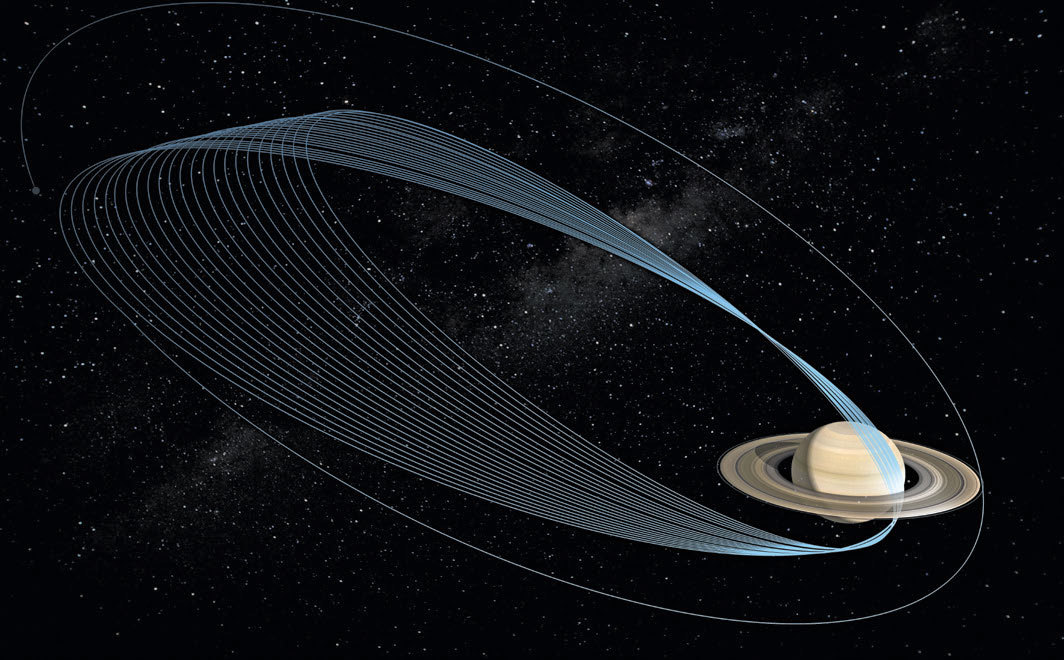On Sept. 15, 2017, the Cassini spacecraft made a fateful plunge into Saturn's atmosphere, ending the mission just one month shy of its 20th launch anniversary.
Projected Times
Because Saturn is so far from Earth, Cassini was gone for about 83 minutes by the time its final signal reaches the Deep Space Network's Canberra station in Australia on Sept. 15, 2017.
The predicted time for loss of signal on Earth was 4:55 a.m. PDT (7:55 a.m. EDT) on Sept. 15, 2017. This time changed as Saturn's atmosphere slowed Cassini during each of the final orbits.
Times in left column are spacecraft event time, i.e., when the events happened at Saturn. "ERT" (in right column for some entries) refers to Earth received time, which is the time when the spacecraft's signal relaying the event arrived on Earth. After events happened at Saturn, it took 83 minutes for Cassini's radio signal to reach Earth.
These times were estimates and changed slightly due to the density of Saturn's atmosphere encountered by the spacecraft in its final five orbits.
Event happens at Saturn | Signal received on Earth | |
|---|---|---|
Sept 8 | ||
8:09 pm EDT (5:09 pm PDT) | Final dive through the gap between Saturn and the rings (closest approach to Saturn is 1,044 miles, 1,680 kilometers above the cloud tops) | |
Sept 9 | ||
9:07 am EDT (6:07 am PDT) | Downlink of data from last Grand Finale dive begins | 10:29 am EDT (7:29 am PDT) |
Sept 11 | ||
3:04 pm EDT (12:04 pm PDT) | Final, distant Titan flyby (aka, the "goodbye kiss") closest approach (altitude 73,974 miles, 119,049 kilometers above Titan's surface) | |
Sept 12 | ||
1:27 am EDT (10:27 pm PDT - Sept. 11) | Apoapse, or farthest point from Saturn in the orbit (800,000 miles, 1.3 million kilometers from Saturn) | |
7:56 pm EDT (4:56 pm PDT) | Downlink of final Titan data begins | 9:19 pm EDT (6:19 pm PDT) |
Sept 14 | ||
3:58 pm EDT (12:58 pm PDT) | Scheduled time when the final image will be taken by Cassini's cameras | |
4:22 pm EDT (1:22 pm PDT) | Spacecraft turns antenna to Earth; communications pass begins for final playback from Cassini's data recorder, including final images. Communications link is continuous from now to end of mission (~14.5 hours) | 5:45 pm EDT (2:45 pm PDT) |
Deep Space Network station in Canberra, Australia, takes over tracking Cassini to end of mission | 11:15 pm EDT (8:15 pm PDT) | |
Sept 15 | ||
1:08 am EDT (10:08 pm PDT - Sept. 14) | High above Saturn, Cassini crosses the orbital distance of Enceladus for the last time | |
3:14 am EDT (12:14 am PDT) | Spacecraft begins a 5-minute roll to point instrument (INMS) that will sample Saturn's atmosphere and reconfigures systems for real-time data transmission at 27 kilobits per second (3.4 kilobytes per second). Final, real-time relay of data begins | 4:37 am EDT 1:37 am PDT |
3:22 am EDT (12:22 am PDT) | High above Saturn, Cassini crosses the orbital distance of the F ring (outermost of the main rings) for the last time | |
6:31 am EDT (3:31 am PDT) | Atmospheric entry begins; thrusters firing at 10% of capacity | 7:54 am EDT (4:54 am PDT) |
6:32 am EDT (3:32 am PDT) | Thrusters at 100% of capacity; high-gain antenna begins to point away from Earth, leading to loss of signal | 7:55 am EDT (4:55 am PDT) |
Pinpointing a Moment
As Cassini headed for its Sept. 15 plunge into Saturn, the mission team continued to update their predicted time for loss of signal. This is the predicted time during Cassini's dive into Saturn when the spacecraft was expected to begin tumbling due to increasing atmospheric density, permanently severing the spacecraft's radio link with Earth. At that point the spacecraft's mission is over.
The predicted time for loss of signal changed because of effects from Saturn's atmosphere on each of the spacecraft’s final five orbits. On these passes, Cassini dipped briefly into Saturn’s upper atmosphere, which caused drag. This drag alterd Cassini’s velocity, which in turn affected when the spacecraft would reach Saturn’s atmosphere on the mission’s final day. More drag made the spacecraft slow down in its orbit, which moved the end-of-mission time slightly earlier. The time could also have move forward slightly if the atmosphere had turned out to be less dense than expected based on the previous passes.
Cassini’s flight team reviewed the trajectory after each pass to see how the spacecraft's course was affected by the atmosphere. They used the new information to update their prediction of how the remaining passes would further alter the trajectory, and from these predictions they generated an updated time for loss of signal.
Read More






